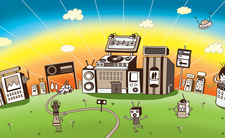mtPaint makes painting easy
Pixelized

You can create pixel art in just a few mouse clicks with the paint program mtPaint, and it can even teach your works of art how to walk.
Paint programs are not image editing programs. Instead, the software focuses on features involved in drawing. You cannot, therefore, expect that an application like mtPaint [1] will play in the same league as Gimp. A comparison with MyPaint [2] or Krita [3] would be more appropriate. Nevertheless, you will find many features of classic image editing programs in paint programs. mtPaint loads bitmap images, manages up to 1,000 layers, and allows users to adjust an image's brightness and contrast, as desired.
Whereas Krita and MyPaint tend to emulate intuitive painting, as with real pens or brushes, mtPaint's objective is different: It focuses on pixel art. This art form uses raster graphics and, in doing so, deliberately highlights the limited resolution of screens as a stylistic device. The style makes a – partly ironic – reference to the beginnings of video and computer game screen graphics and of the graphical user interfaces used on computers in the 1980s and the early 1990s. Invader, a French street artist [4], is one of the best known artists of this genre.
Mark Tyler, the developer of mtPaint, says his objective was to write a sleek, reliable, fast, but simple-to-operate program – and this is exactly how mtPaint seems from the start (Figure 1). The application's architecture is clearly arranged, and the painting features are spread over several locations. You will find the most frequently required tools in the toolbar. The program places the typical palettes, from which you can take colors, on the left edge of the screen. A quick selection tool for brushes lies above this palette strip (Figure 2).
[...]
Buy this article as PDF
(incl. VAT)
Buy Linux Magazine
Subscribe to our Linux Newsletters
Find Linux and Open Source Jobs
Subscribe to our ADMIN Newsletters
Support Our Work
Linux Magazine content is made possible with support from readers like you. Please consider contributing when you’ve found an article to be beneficial.

News
-
Linux Mint 22.3 Now Available with New Tools
Linux Mint 22.3 has been released with a pair of new tools for system admins and some pretty cool new features.
-
New Linux Malware Targets Cloud-Based Linux Installations
VoidLink, a new Linux malware, should be of real concern because of its stealth and customization.
-
Say Goodbye to Middle-Mouse Paste
Both Gnome and Firefox have proposed getting rid of a long-time favorite Linux feature.
-
Manjaro 26.0 Primary Desktop Environments Default to Wayland
If you want to stick with X.Org, you'll be limited to the desktop environments you can choose.
-
Mozilla Plans to AI-ify Firefox
With a new CEO in control, Mozilla is doubling down on a strategy of trust, all the while leaning into AI.
-
Gnome Says No to AI-Generated Extensions
If you're a developer wanting to create a new Gnome extension, you'd best set aside that AI code generator, because the extension team will have none of that.
-
Parrot OS Switches to KDE Plasma Desktop
Yet another distro is making the move to the KDE Plasma desktop.
-
TUXEDO Announces Gemini 17
TUXEDO Computers has released the fourth generation of its Gemini laptop with plenty of updates.
-
Two New Distros Adopt Enlightenment
MX Moksha and AV Linux 25 join ranks with Bodhi Linux and embrace the Enlightenment desktop.
-
Solus Linux 4.8 Removes Python 2
Solus Linux 4.8 has been released with the latest Linux kernel, updated desktops, and a key removal.

